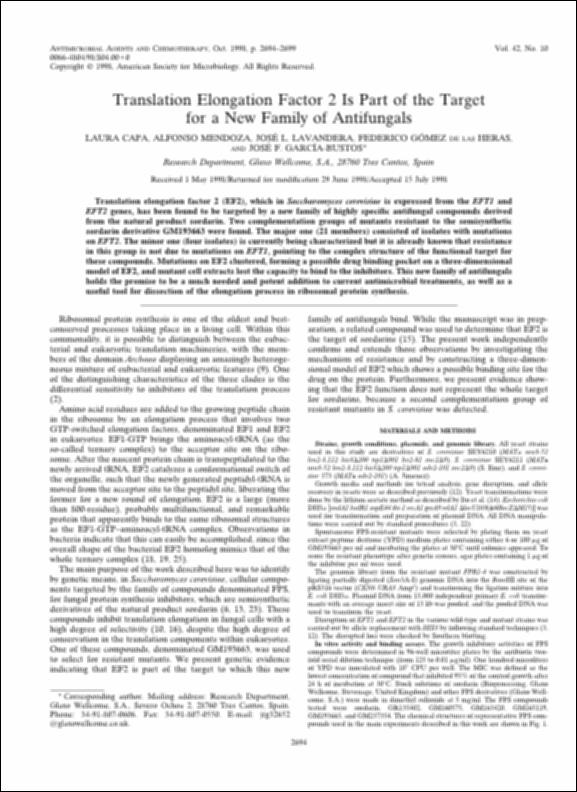Please use this identifier to cite or link to this item:
http://hdl.handle.net/10637/5517Translation elongation factor 2 is part of the target for a new family of antifungals
| Title: | Translation elongation factor 2 is part of the target for a new family of antifungals |
| Authors : | Capa, Laura Mendoza, Alfonso Lavandera Díaz, José Luis Gómez de las Heras, Federico García Bustos, José F. |
| Keywords: | Compuestos heterocíclicos. |
| Abstract: | Translation elongation factor 2 (EF2), which in Saccharomyces cerevisiae is expressed from the EFT1 and EFT2 genes, has been found to be targeted by a new family of highly specific antifungal compounds derived from the natural product sordarin. Two complementation groups of mutants resistant to the semisynthetic sordarin derivative GM193663 were found. The major one (21 members) consisted of isolates with mutations on EFT2. The minor one (four isolates) is currently being characterized but it is already known that resistance in this group is not due to mutations on EFT1, pointing to the complex structure of the functional target for these compounds. Mutations on EF2 clustered, forming a possible drug binding pocket on a three-dimensional model of EF2, and mutant cell extracts lost the capacity to bind to the inhibitors. This new family of antifungals holds the promise to be a much needed and potent addition to current antimicrobial treatments, as well as a useful tool for dissection of the elongation process in ribosomal protein synthesis. |
| Description: | Artículo en colaboración con : Laura Capa, Alfonso Mendoza, Federico Gómez de las Heras y José F. García-Bustos En: Antimicrobial Agents and Chemotherapy. ISSN 0066-4804. v. 42, n. 10, 1998, págs 2694-2699 |
| URI: | http://hdl.handle.net/10637/5517 |
| Rights : | http://creativecommons.org/licenses/by-nc-nd/4.0/deed.es |
| Issue Date: | 29-Oct-1998 |
| Center : | Universidad San Pablo-CEU |
| Appears in Collections: | Medicina |
Items in DSpace are protected by copyright, with all rights reserved, unless otherwise indicated.


